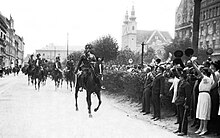| Uprising in West-Hungary | |||||||||
|---|---|---|---|---|---|---|---|---|---|
 Map of present-day Burgenland in Austria, the area of the short-lived state of Lajtabánság and military conflicts | |||||||||
| |||||||||
| Belligerents | |||||||||
|
|
| ||||||||
| Commanders and leaders | |||||||||
|
Iván Héjjas Gyula Ostenburg-Moravek Mihály Francia Kiss Károly Kaszala István Friedrich Gyula Gömbös | |||||||||
| Strength | |||||||||
| ~500 Austrian police officers and gendarmeries | ~500-600 | ||||||||
| Casualties and losses | |||||||||
|
12 killed 46 wounded | 24 killed | ||||||||
You can help expand this article with text translated from
the corresponding article in Hungarian. (May 2012) Click [show] for important translation instructions.
|

According to the Treaty of Trianon, the city of Sopron in western Hungary and its surroundings were assigned to Austria. After an uprising in 1921 in this region, a referendum was held and 65.08% of the votes were in favor of belonging to Hungary. This referendum was accepted by the major powers and the transition of Sopron and its surrounding 8 villages from Austria to Hungary was the only serious territorial revision in the years following the Treaty of Trianon.
In literature
- Gyula Somogyvári („Gyula diák”): És mégis élünk (novel)
- Dr. Jenő Héjjas: A Nyugat-magyarországi felkelés. Budapest, 1929.
See also
References
This article includes a
list of references,
related reading, or
external links, but its sources remain unclear because it lacks
inline citations. (February 2017) |
Sources
- József Botlik. "A második nyugat-magyarországi felkelés". Vasiszemle.hu. Retrieved 30 July 2011.
- Sándor Sarkady, Jr. "Tüzek a végeken". w3.sopron.hu. Retrieved 30 July 2011.
External links
- Mária Ormos. "A nyugat-magyarországi felkelés". sopron.hu. Retrieved 30 July 2011.
- József Botlik. "A második nyugat-magyarországi felkelés". Vasiszemle.hu. Retrieved 30 July 2011.
- Békés Márton. "A fegyveres revízió útja Nyugat-Magyarországon". vasiszemle.t-online.hu. Retrieved 31 July 2011.